Garmin Forerunner 610 Review
Garmin Forerunner 610
Garmin's new flagship GPS sport watch sets a pace and breaks away from the pack.
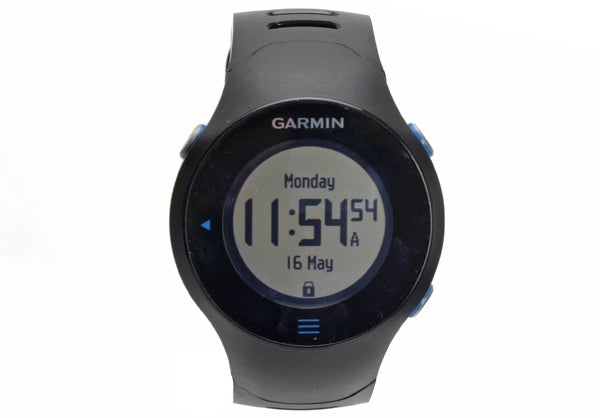
Verdict
Pros
- Advanced features
- Resistive touchscreen
- Alarm clock and vibrate alert
Cons
- Long charging time
- Not fully waterproof
- Expensive
Key Specifications
- Review Price: £359.00
- Long battery life
- Virtual partner
- Touchscreen
- Customisable display
- Location marking
The manufacturer’s latest watch is the Forerunner 610. It takes everything Garmin knows about sport technology, puts it in a better product and makes it easier to use.
The 610 does away with the touch bezel of the Garmin Forerunner 410, which we criticised for being an impossible combination of both too sensitive when you don’t want to use it and unresponsive when you do. The bezel was also a feature of the Forerunner 405 and was a great idea on paper, but we don’t run on paper. Real runners run in the dark and the wet and the rain, and a wet sleeve would activate the 410’s backlight or open various menu options during a workout.
In its place, Garmin has developed a resistive touchscreen that is surprisingly responsive, without being too sensitive, and reacts to the user’s deliberate touch. What it lacks in the premium feel of a capacitive touchscreen it more than makes up for in practicality because it can be operated while wearing gloves, something that will be a welcome development to non-fairweather runners.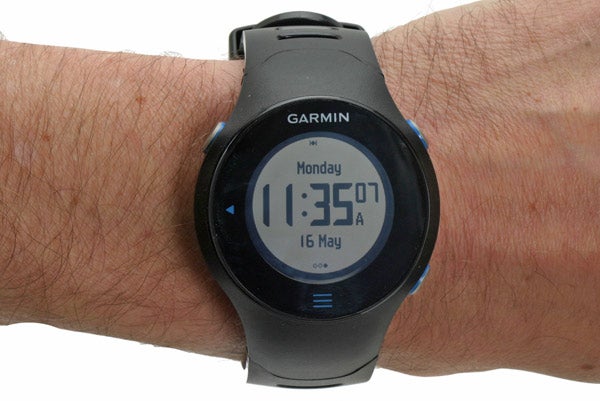
The 1in LCD inch screen is clear to read with a good backlight, operated with a button on the top-right of the face. The screen’s 128×128-pixel panel is small enough for the watch not to dominate your wrist like the Timex Global Trainer, but still large enough to be read clearly – it also has good viewing angles.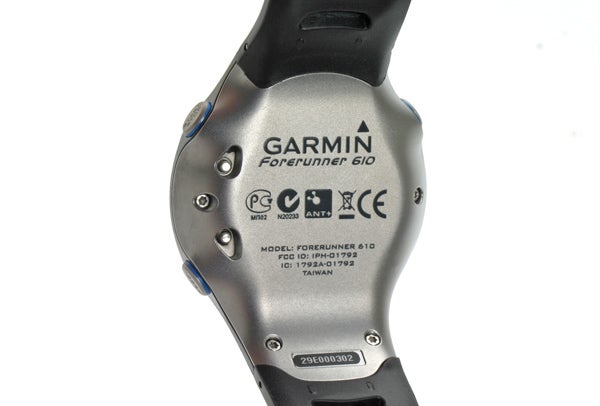
Unlike the older, waterproof – and frankly massive – Forerunner 310XT, the 610 is waterproof rated at IPX7, meaning it can withstand being submerged for 30 minutes at a depth of 1m. It passed our test of running in heavy rain, but it is not intended for swimming, and at this premium price, you’d be ultra-marathon bonkers to challenge the rating.
The watch measures 4.57 x 6.35 x 1.42 cm and is lower in profile than the Forerunner 410 and the Nike SportWatch. It weighs 75g, 12g more than a G-Shock Classic, and has a metallic casing that covers the back and the sides of the body.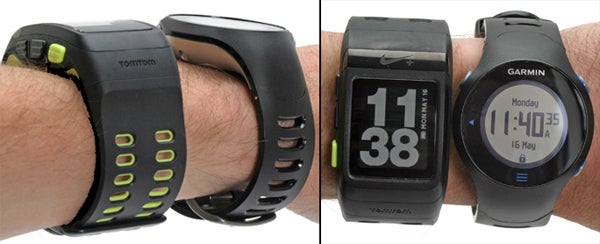
The screen is unlocked from its wristwatch slumber with a swiping motion, revealing the main menu. The menu system layout marks a big improvement on previous models. The structure puts History and Training at the top level, instead of burying previous workout stats as a subset of Training.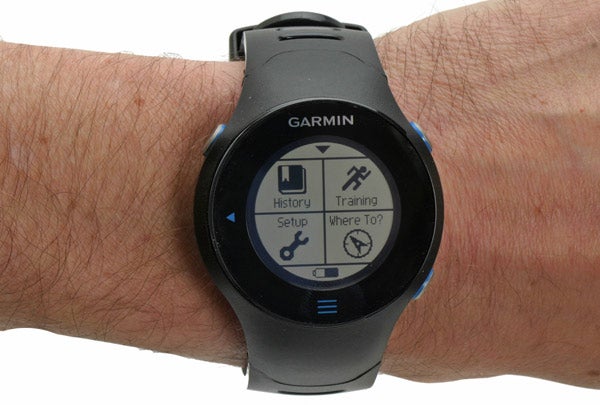
Runners love their stats. They love other runners’ stats too, and the online Garmin Connect service is a haven for training analysis. Workout data is transferred wirelessly to a computer using the Ant USB stick. Recording a run is easy – the Forerunner 610 combines the eager simplicity of the Nike SportWatch with the advanced functionality of the 410.
Instead of accessing the Training menu, you simply swipe to the Timing page and the watch starts looking for a fix on a satellite, which it finds in under a minute. Even in built-up areas and forests the 610 was able to locate a signal relatively quickly.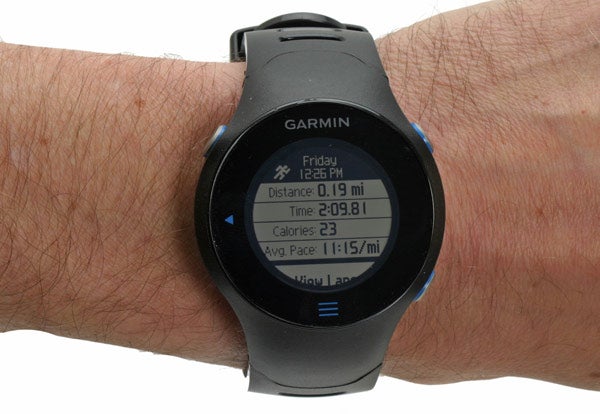
In-run controls take full advantage of the touch screen, allowing a runner to swipe between menus displaying up to four screens of customisable data, showing everything from heart rate, calories burned, speed, pace, time and distance. Screens can also be set to autoscroll so you can review your details on the move without having to touch the watch.
Runs can be uploaded wirelessly to the Garmin Connect Service to display more detailed stats and record or share your details online. (View details our 10k test run)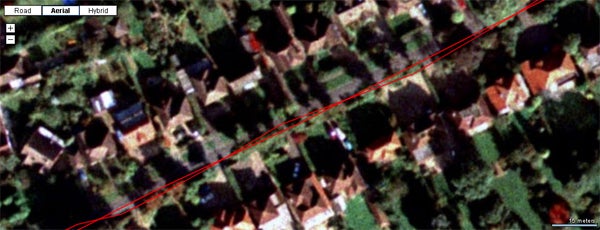
The 610 accurately passed our zigzag test while we ran down a road, showing up the pattern as we altered our position by a few feet.
Battery life is excellent at four weeks on watch mode and eight hours in training mode with GPS turned on. For a real-life view, we charged the watch on Friday and went for a 10k, 53-minute run the following Tuesday and had 50 per cent battery life left.
While the battery lasted longer than the 410’s, it did take nearly twice as long to charge at almost three hours. However, the watch is easy to power down into sleep mode. If you want to save the battery, you can hold down the Power/Light button on the top-right of the watch, as opposed to the Forerunner 410, which required the user to go through a Menu>Setting>System>Shutdown>Yes process to shut down.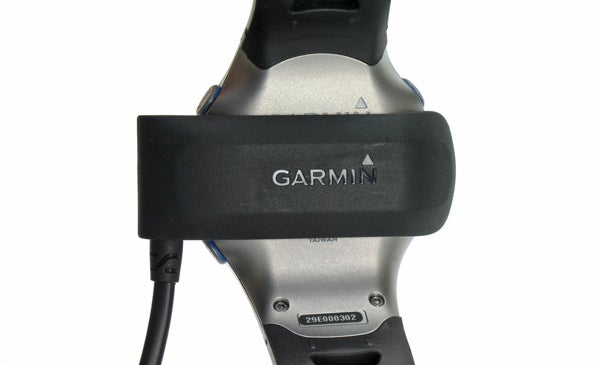
The charger connects magnetically and is more sturdy than Garmin’s previous clasps, which can be knocked loose. The design and metallic back of the watch ensures a secure connection while the watch is being charged.
Additional features include a Virtual Partner, letting you can time yourself against a target pace to keep up with. However, it doesn’t have the Courses functionality of the 410. This allowed you to compete against a previously-completed run. This may be a small omission, but one Garmin felt happy to leave out.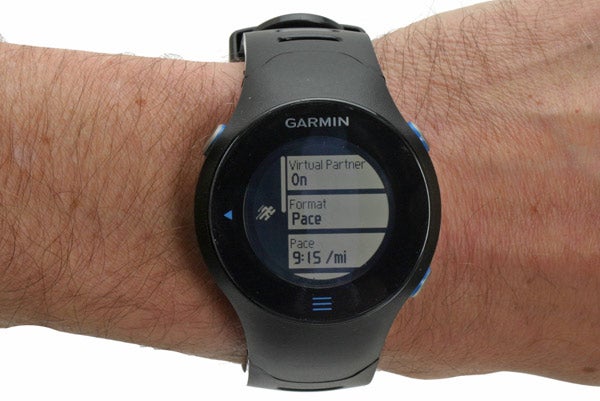
The watch can be set to alert you if you drop below a target pace or speed, and you can set interval training to customise a walk/run or jog/sprint routine. The notification can be set to either beep or vibrate – another welcome addition and a first for a sport watch.
Both Virtual Partner and the custom workouts can be set on the watch itself without the need to connect it to a PC, unlike the Nike SportWatch which needs to be tethered to a computer just to change the time. In fact, the 610 allows users to set the time manually, a simple feature overlooked by the 410.
Among other advanced features is the Where To option, which allows you to pinpoint and save up to 100 locations, from a parked car or a friend’s house, and return them using a bearing and distance. It’s not exactly turn-by-turn navigation, but it’s a function lacking in most sport watches. And one any distance runner who has gotten lost on a run before would welcome.
The watch is compatible with the Garmin Foot Pod sensor, letting the Forerunner 610 function when on a treadmill or in an area with no satellite reception. Cyclists can opt for a Cadence Sensor, which clocks pedalling strokes per minute to measure the speed of an indoor trainer. These cost £51 and £35 respectively.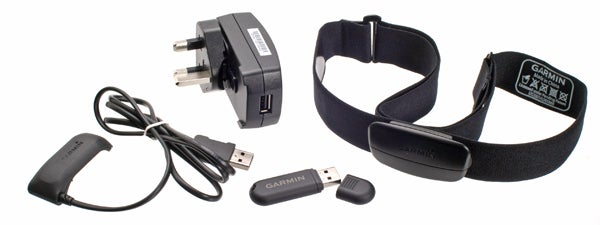
Finally, the watch is fully geared-up to work with a heart rate monitor, costing £40 when sold separately, although the 610 HRM package is just £30 more when bought with the watch. Runners who want to monitor their pulse during training can programme target zones to optimise fat burning and maximize overall fitness. It’s also worth noting that the watch is compatible with the strap supplied with the Forerunner 210 and 410, and although Garmin claims the new monitor is more accurate, we found the previous versions of the accessory to be equally reliable in our tests.
Verdict
The Garmin Forerunner 610 is an outstanding device. It’s versatile, responsive, accurate and well-designed. It’s not just the big things like how it’s packed with features, and the way they are accessed and arranged in such a logical way. Small details matter, like being able to set the time manually while on a flight without having to connect to a computer or find a satellite signal, using a magnetic charger, or having the scrolling touchscreen menus.
It’s a great product with a hefty price. While the 410 launched at £300 with a heart rate monitor, the 610 is a hefty £359 with HRM or £329 without. The Forerunner 610 is aimed at the high end of the market. Runners on a budget should opt for the Garmin Forerunner 210, but the 410 has simply been outclassed by the improvements made by Garmin’s flagship sport watch. We would love to see a faster charge time and a waterproof casing but, put simply, this is the best GPS sport watch on the market today.
Trusted Score
Score in detail
-
Usability 10
-
Features 10
-
Value 7
-
Design 8

